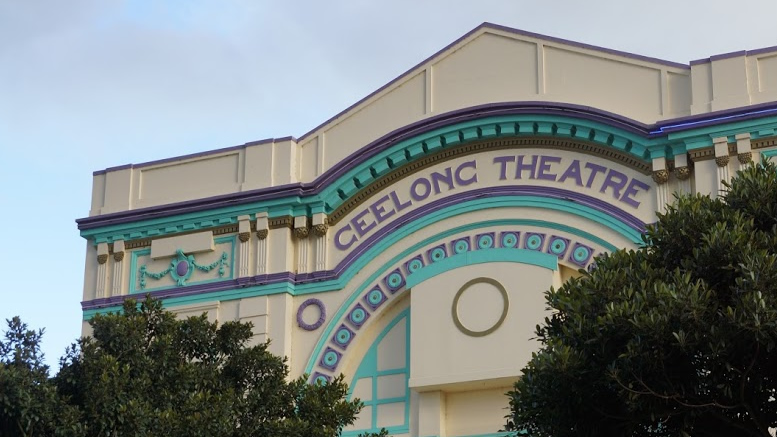Geelong has a vibrant theatre scene, but a lot has changed throughout the decades. We have lost many magnificent theatres to changing tastes, technological progress and the need to redevelop key pieces of land within our city. Here are a few theatres that have played an integral part of Geelong’s heritage and history.
If anyone has any updates or stories that can help us piece together Geelong’s theatre past, we would love to hear from you. Drop us a line or contact us on Facebook or Twitter.

Chilwell Embassy / Astor Cinema
Russel Street in Chilwell, now Newtown, was home to the Chilwell Embassy Cinema. The building was commissioned in 1899 at a cost of 700 pounds and was first known as Sladen Hall followed by the Astor Theatre. The hall was remodelled in 1940 to accommodate the weekly talkie picture programs after being used for several uses. In November of 1857 fire broke out and raised the building to the ground along with a nearby library and child health centre, with the fire being blamed on a discarded cigarette butt. The library and child health clinic were eventually rebuilt but the old cinema is long gone. In its place is a park called Sladen Park, a nod to the former theatre and Sir Charles Sladen, who built it back in 1899. Charles Sladen’s historic house is still standing down the road in Newtown and it is one of Geelong’s most historic properties. The magnificent blue stone property has been a popular reception centre especially for weddings for decades.
The Corio Theatre
The Corio Theatre was located in Malop Street and was a favourite theatre for screening films from when it opened in 1948 right up to its demolition in the early 1980s. The beautiful Art Deco architecture of the Corio was lost when it made way for the car park ramp of the new Market Square Shopping. The interior was magnificent with an upper level dress circle and deep stalls. The Corio is often remembered by many Geelong teenagers of the time who became the wrath of the attendants spotlight interrupting an impromptu passionate moment during the Saturday afternoon matinée.
His Majesties
Large scale exhibitions were once very popular, in the late 1880s it was a perfect opportunity to show off the latest technological inventions of the day to the masses. In 1881 Geelong was host of the Juvenile and Industrial Exhibition, which was a small-time world fair, a bit like a mini Expo 88. To house this wondrous exhibition a giant hall was commissioned that later become the Exhibition Theatre. Located in Jacob Street, that was lost to the Market Square Shopping Complex, the theatre would have stood close to where the escalators to Harris Scarfe stand today. The theatre was later named both Her Majesties and His Majesties in honour of the reigning Crown. The theatre could accommodate 1500 guests and even popular opera singer Dame Nellie Melba is known to appear there in February of 1915. The theatre was lost in 1936 when Cowley’s Motor Garage operated on the site until a multi-story car park replaced it in 1961.
The Joy Arc
The Joy Arc is one of Geelong’s most celebrated historical buildings. It was part picture theatre, dance hall and skating rink. It was located over the water from the land we know as HiLite Park, to the west of the Royal Geelong Yacht Club close to where the Waterfront Ferris Wheel is now located. The Joy Arc was built in 1912 and only lasted a short time before being demolished in the mid 1920s. For those visiting the waterfront precinct there is a lovely bollard decorated to commemorate of the Joy Arc close to the original location. Parts of the building were said to be used in the construction of the Palais Royal that still stands at the top of the Moorabool Street hill.
Palais Royal
The Palais Royal or simply the Palais as we know it today sits at the top of the hill in Moorabool Street. This complex was built in 1926 and was a popular motion picture cinema and dance hall. During the 1950s as cinema became more advanced, cinemas with sloping floors became more popular, so film was slowly phased out at the flat floor Palais. Dancing became the major use of the theatre, and boxing and bands soon followed. During the 1980s it became one of Geelong’s bigger band venues, hosting such names as INXS, Cold Chisel, Icehouse and even UK metal outfit Motorhead. In the past few decades it has become a bingo house and plans are underway to develop the Palais into a premier reception and convention centre.

Pix Geelong West
The Pix Cinema was located in Elizabeth Street West Geelong and ran from the 1950s through until the early 1990s. Through most of its life it was an independent cinema but in its last few years it was ran by the Village. They used it as Geelong’s only cinema during their huge rebuild of their Geelong cinema and closed it a short time after. The building still exists today and was used for several years by a local religious group. In early 2015 it was revealed that a covenant was placed on the property by Village that restricted the building from showing films ever again. A local pop up cinema was hoping to show art house and independent films in the venue, but sadly without Village’s help in removing the covenant the cinema was put on the market to never again show another film on the big screen. Today the building is unrecognisable from the street but much of the outer walls and old roof trusses were retained in a modern 2 unit redevelopment of the building.
Pivitonian Cinema
A few years back the Pivitonian Cinema started as a pop up cinema at a hall in Pakington Street mainly showing art house and independent films that the other two cinemas in town were not interested in. Fast-forward to 2016 and the group now have a permanent home on the corner of Moorabool & Verner Street in South Geelong. This new theatre brings all the comforts of the big cinemas in town as well as modern 2K digital quality films.
The Plaza
The Plaza was located behind the Ryrie Street facade of the Mechanics Institute and some of it still stands today. Much of the Plaza was demolished in the mid 1970s to make way for the brand new Geelong Performing Arts Centre, or GPAC, that opened in 1978. Some exterior and internal structure of the Plaza still remains today including much of the arch roof of the Playhouse Theatre, or Ford Theatre as it was previously known. In 2018 the Mechanics Institute facade was removed to build a new entrance to GPAC in front of the Playhouse Theatre.
Readings
Our early cinemas used clunky and scratchy black and white reels with no sound, but today they are high-definition with digital sound, incredible special effects and even 3D technology. In March of 2003 in answer to the city’s Village megaplex, Readings Cinema’s opened in Waurn Ponds helping change the way Geelong people enjoy their movies in the new century. With comfortable stadium seats, huge screens and the ever popular lolly bar with its huge serves of popcorn and drinks. One thing hasn’t changed is the sheer enjoyment and of course the famous Jaffas and choc top ice-creams; a staple in any cinema.
The Regent Theatre
The Regent Theatre was located on the corner of Little Malop Street and Union Street where Dimmy’s Department Store now stands on the Mall. The Regent opened back in 1922 and was converted to cinema-scope in 1956. The theatre continued for another decade and screening its last film in January of 1965. Sadly the Regent’s grand facade was lost, and was replaced with the drab flat rendered concrete wall that today adorns this once grand building. For much of the 70s and 80s the old Regent was home to McEwan’s Hardware Store before it moved into the new Market Square for a short period. The Reject Shop later took over the building and in more recent times, Dimmys. But still today there are some treasures of the Regent still in existence, with the spectacular ornate ceiling still remaining. It can be seen from the top floor of the building that is no longer open to the public.
Star Drive In Moolap
Located in Moolap Station Road, Moolap the Star Drive In opened in 1955 and served for 30 years before closing in 1984. Drive Ins were huge business during the 50s, 60s and 70s but technological transformations including big budget special effects and surround sound took their toll and now there are very few left remaining around the country. Today, the property the Star Drive In was located on stands bare, home to a few farm animals, but the old metal gates remain as a reminder of the glory days of Drive In cinema.
Village Geelong Drive in
Ballarat Road Bell Post Hill was home to Geelong’s other Drive In. This venue opened in the 1950s and was the last to close, lasting up until 1994. Replaced by a private house, today only the main gates remain as a legacy of this bygone era of Drive Ins in Geelong.
Village Geelong Theatre
Today we know the Village Cinema as a megaplex with a dozen or so screen featuring digital sound and 3D capabilities but this has not always been the case. The theatre has had a long and interesting history. Built in 1911, there are many features still in existence today from the original theatre. Including the beautiful facade that was uncovered after hiding behind nearly 30 years of ugly 70s cladding. The original theatre was one theatre, with a lower level and upper level. This was split in two and opened as the Village Twin in 1970 with the premier of Towering Inferno. Cinema Two, the upstairs theatre became one of the largest cinemas in Australia and retained much of the original 1911 ceiling. In 1995 work began on extending the complex to become the Village 11. Several new cinemas were added to the rear of the property and the original Cinema 1 and 2 were refurbished (now known as cinema 1 and 4). It is said that a stage once existed behind the cinema 1 screen, this was removed to make way for a small gold class cinema.
